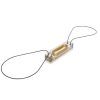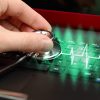Biomarkers, or biological markers, are objective measurements indicative of a specific biological state, often measured to evaluate a particular condition or process. At its most basic form, a biomarker can be a single data point such as temperature, or it can be a more complex combination of data points that together indicate the presence, imminence or severity of a physiological situation.
The study of specific biomarkers can play a significant role in clinical trials and research, patient access to new treatments, medical product development, and clinical decisions by offering providers access to more information.
RPM as a Viable Tool
The FDA and National Institutes of Health (NIH) published the BEST (Biomarkers, EndpointS, and other Tools) Resource in 2016 as an ongoing resource regarding biomarkers and clinical assessments and the role in research, product development and regulation. Part of that content includes how wearable sensors and digital tools can capture biomarkers through remote patient monitoring (RPM) devices.
RPM products with medical-grade sensors can play a dynamic role in developing personalized medicine, a growing area that focuses on tailoring treatments to the individual patient. To create the appropriate diagnostic tests or monitoring solutions, the RPM device must meet multiple criteria, including providing consistent, quality data and being easy enough to use that it is not prohibitive for the patient. Continuous, quality data capture via RPM devices can help develop biomarkers to create new clinical applications.
Ease of use is critical to ensure patients follow through with protocol guidelines. Even if researchers are not monitoring the information 24 hours a day/seven days a week, those conducting a study can continually collect a variety of data so the layers of information can be processed through the appropriate algorithms to get a complete picture. Qualitative ease of use and quantitative technology create a viable RPM product.
Biomarkers in Clinical Trials
The University of California, San Francisco (UCSF) recently used a continuous wearable ECG sensor for a 3,000 subject multi-year study on atrial fibrillation (AF). The 10-year study aims to detect biomarkers of early atrial transformation in AF.
AF is one of the most common abnormal heart rhythms and a major cause of stroke and heart failure. However, due to a lack of options to identify at-risk patients, the current treatment method is to wait until patients develop arrhythmia. One of the critical challenges is the lack of simple and cost-effective solutions for monitoring over an extended and continuous period. Subjects in this study are monitored to capture ECG and heart rate continuously 24 hours a day. Each subject wears the ECG sensor for one week every month, even while ambulatory or at home. A mobile app captures the data from the sensor and sends it to the cloud for analysis. The intent is to identify imaging, serum and digital biomarkers of AF risk and progression using the ECG sensor to capture a larger continuous dataset. By measuring the heart rhythm throughout a timeline, the pattern can become a biomarker indicative of the likelihood of developing AF, which could then be treated accordingly. The sensor patch can also capture data on the respiratory rate and activity levels to add to the dataset as needed for additional layers of information.
Another key example lies in a clinical trial related to chemotherapy and neutropenia. While it’s common for cancer patients to develop a fever after treatment, it is critical to determine when it becomes enough of an issue to require additional hospitalization. The study correlated multiple parameters captured by continuous ECG and axillary temperature monitors. The heart rate, respiratory rate and temperature were captured to create a biomarker to study multi-vital trends and possible correlation. The data collection correlated together developed a biomarker that could be monitored to detect a potential serious physiologic event up to 18 hours in advance.
Addressing major societal health issues can be facilitated by using RPM technology to better understand the biomarkers—or signals—that a problem is imminent. This is a priority for the NIH and its National Institute for Drug Abuse (NIDA) in its study to monitor individuals with opioid addiction disorders. The study aims to help researchers understand patterns in vitals such as heart and respiratory rates that could indicate a relapse. While in the early phases, the research on the physiologic biomarkers is promising.
Beyond the traditional clinical study realm, RPM devices help proactively monitor heart and respiratory rates, and stress levels, to create biomarkers regarding heart rate viability in athletes in sports such as rowing, as reported in Nature Partner Journals.
Qualitative and Quantitative Tools
Studies such as these can help expedite safe and effective treatments by providing quality critical data points that become biomarkers. The ability to discover and detect these biomarkers is heavily enabled by RPM technologies that are user-friendly and multi vital. That requires quality sensors in the monitoring tools, continuous monitoring and infrastructure behind the tool to integrate the data into an appropriate technology platform efficiently. These sensors extract the most relevant biomedical signals through a comprehensive approach to RPM, including tuning the sensors and the signal processing with an understanding of the underlying biomedical principles.
A major differentiator in sensor devices’ quality is classification as medical grade, but there are multiple levels within that distinction depending on the applications. A medical-grade sensor can be cleared and validated against a baseline, but it also has to be the best product for a specific application, such as monitoring patient vitals. RPM sensors can be used to measure data points that create the biomarkers that serve as the basis for developing a routing diagnostic for clinical use. The effective, efficient combination of quality data and appropriate quantity creates the optimum RPM tool.







